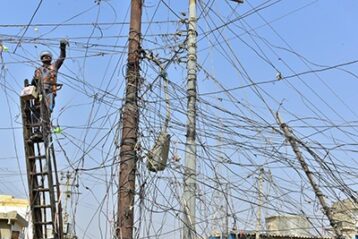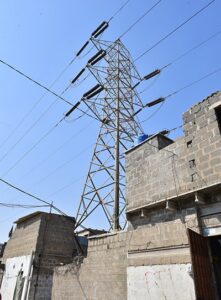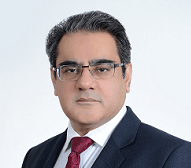There is always another side to every story. For detractors, the K-Electric (KE) may appear as a huge villain because of the frequent power outages in the megalopolis, but the fact is, the company’s management is mired in the proverbial Catch-22 situation — for no fault of its own.
The government and state-run utilities, including the Sui Southern Gas Company (SSGC), complain that the KE owes them around 110 billion rupees, which includes over 90 billion in interest charges. But the KE management also has a woeful story to tell about the unpaid bills owed to it, amounting to at least net 230 billion rupees. The KE cannot charge interest even if its payments are being delayed.
“I blame myself for the situation,” says Chairman KE Shan A. Ashary. “The agreement says that the government has to clear our dues within 30 days. But we should have added a clause regarding what would happen if the dues weren’t cleared within the stipulated time. We believed that since it is the government, it will be fair. It will surely pay us in 30 days, if not, maybe 60 or at the most 90, or in 120. After all, it is the government. But some of our dues are still outstanding for the past many years — a real risk we did not foresee.”
Ashary was appointed KE chairman in September 2020 — barely six months ago — but his association with the power utility spans more than 15 years. Prior to assuming the position of chairman, he had been the longest-serving director on the KE board.
Ashary is a Karachiite, but has spent all his professional life abroad, working for big Middle Eastern investors for the last 30 years. He played a pivotal role in the privatisation of the power utility in 2005, named the Karachi Electric Supply Corporation (KESC) at that time. Ashary brought Saudi Arabia’s Aljomaih Group and Kuwait’s National Industries Group (NIG) to Pakistan to buy stakes in the KESC. In 2008, he brought the second chunk of foreign investment for the KE by joining hands with the now defunct Abraaj Group.

But the KE proved the most challenging of all his investment ventures spread over several countries — from North America to Europe and from the Middle East to the Far East. The KE’s unpaid dues by the government and its various entities — some dating back to 2005 — are just one of the many issues plaguing the utility.
The other pressing issues include the absence of dividends for 15 years to shareholders and investors, failure to execute the KE’s sell-out deal to Shanghai Electric, despite the lapse of more than four years, and delayed settlement of disputes with the government over interest payments. Then, there are the daily operational issues of ensuring a steady electricity supply to a mega city like Karachi, where power theft and encroachments around the high-tension cables and their pylons remain rampant and decision-making difficult because of political and social sensitivities.

But the foremost worry is the non-payment of dues and interest slapped on the KE by the state-run Sui Southern Gas Company (SSGC) against the principal amount of 13 billion rupees, which has now ballooned to more than 110 billion rupees. The dispute over interest payment shows how a weak regulatory framework and political expediency damage the investment environment and hurt businesses in the country.
According to Ashary, the KE could not clear the SSGC’s dues on time because other government departments, including the Karachi Water & Sewage Board (KWSB), did not clear dues owed to the power utility. “This issue has been dragging on for more than 10 years now … we owed 13 billion rupees to the SSGC, while the KWSB owed us 30 billion. Our position was that when the government cleared the KWSB dues, we would pay the SSGC … but the situation got complicated as the SSGC slapped interest on top of the principal amount, which multiplies every day.”
Although since 2012 all payments are being made on time, the settlement of the disputed amount remains pending.
Another twist in the tale is the federal government’s position that after the 18th Amendment, the Sindh Government has to pay the KWSB dues, but the province refuses to take this responsibility. The KE’s privatisation, rather than serving as a poster-child for attracting new investment, is perceived as a cautionary tale among foreign investors. The absence of a dispute resolution mechanism, the procedural and approval delays and the policy-makers’ lacklustre response to addressing this issue is eroding Pakistan’s reputation as an investment destination
The KE’s dues pending with the National Electric Power Regulatory Authority (NEPRA) and the Finance Ministry are estimated at around 190 to 200 billion rupees, according to Ashary. “The delayed determination and notification of the KE’s tariffs by almost two years have had a major impact on the company’s sustainability and financial viability.”
Under the agreement, NEPRA has to approve payments in four months and the Finance Ministry has to release them within two weeks. As the KE is not getting its dues on time, it cannot clear the NTDC’s (National Transmission & Despatch Company) bills, which, like the SSGC, has also slapped interest on the principal. The NTDC needs timely payments for Independent Power Projects (IPPs).
It is “a vicious cycle,” said Ashary. “For state-run distribution companies, it is called circular debt, but for the KE it is commercial debt. On a principal to principal basis, if the disputed amount is settled against 230 billion rupees … even then the government owes KE at least 90 billion rupees.”
He continued, “We have to borrow from banks to maintain liquidity … last year, the KE earned a profit of 16 billion, but had to pay 18 billion rupees in interest to banks against loans. The net result — a two billion-rupee loss to the Company. If we get our dues on time, we won’t have to borrow.”
The KE was Ashary’s first, and is so far, his last major investment in Pakistan. Before the KE, in his 30-year-long career he managed the funds for his Middle Eastern investors in various parts of the world. But this is the first time he has had to deal with a situation like this.
“In 2005, like many groups the Aljomaih Group also wanted to invest in India, but I told them that being a Pakistani I was not the man to lead an investment there,” Ashary said, recalling how the KE’s privatisation took place. “I advised the Aljomaih Group to look towards Pakistan.”
Those were the days when President Pervez Musharraf was in power. The economy was expanding and the privatisation programme was being pushed with a new vigour. Ashary arranged the visit to Pakistan of Abdulaziz Al Jomaih, the owner of the Aljomaih Group. The visit was arranged meticulously and Al Jomaih was impressed by what he saw in Pakistan.
“We were interested in Pakistan State Oil (PSO), which was up for privatisation at that time, but Prime Minister Shaukat Aziz asked us to bid for the KESC instead,” Ashray disclosed. “I got the nod from the Aljomaih Group and by joining hands with Kuwait’s NIG, we bought a 71.5 percent stake in the power utility.”
But things did not go as expected. The first decision which went bad was the handing over of operations to Siemens. Ashary says that at that time there were problems within Siemens and it could not turn the KE around as expected. “Within two years the funds began to dry out. At that time, the KESC was seeing an annual loss of around $100 million plus. So, we brought in the now defunct Abraaj, which injected the equity to our dollar for dollar into the K-Electric, acquiring a 50 percent stake in KES Power, the investment holding company.”
“The Abraaj Group replaced Siemens and installed a good management team, which did a great job by turning the Company around. It was good teamwork.”
The natural question here would be, didn’t the Abraaj Group’s troubles and liquidation hurt the KE?
It did not, according to Ashary. “The Abraaj Group was a fund manager like my company (Tricap Investments LLC). Investors simply appoint a new manager in such cases, and this has already been done in the KE’s case.”
But investment in the KE proved a loss-making venture for foreign investors as besides getting nothing in dividends, they also saw their investment eroding. “The dollar was at around 59 to 60 rupees when we brought stakes in the KE by investing $361 million in 2005 and then another $361 million in 2007. Now the rupee has plunged to the level of 159-160 to a dollar.”
Then there’s the story of Shanghai Electric, which wanted to purchase the KE.
“In October 2016, we signed a sale-purchase agreement with Shanghai Electric, but it insisted on a clean slate and resolution of pending issues, including the dispute over interest,” said Ashary.
He added that Shanghai Electric recently wrote a letter reiterating its commitment to buy the controlling stakes in the KE and complete the takeover process in seven months — but reiterated that this would be contingent upon the issues being resolved.
“Shanghai Electric has explained the take-over process line-by-line and now we await action from the government.”
Ashary said that the point of concern is why a foreign investor should have to wait that long for dispute resolution. “I am a Pakistani, but also a foreign investor. Officials here don’t realise the efforts we made, first to bring foreign investors here, and then to manage their disappointment.”
The life of a private equity fund is seven to ten years and after that the life of the fund expires. “Equity funds don’t invest with a horizon of 50 years like that of Shanghai Electric. Aljomaih and NIG came as direct investors, while Abraaj came in as a fund, which had to turn around the Company and make it attractive to someone like Shanghai by 2016, which couldn’t be materialised,” said Ashary.
Is the Shanghai Electric deal good for KE?
“Yes, simply because Shanghai is a strategic investor with a long-term horizon of 50 years and more,” said Ashary. “Shanghai Electric is a utility company, which wants to expand to different parts of the world. They have technical, operational and administrative expertise and financial resources to operate the KE … Pakistan also has a close friendship with China. You won’t find a better investor than Shanghai Electric.”
With Pakistan generating excess electricity, was there a need for a new power plant?
Ashary says that just a few years ago, Pakistan faced an acute electricity shortage and getting even 650 megawatts for Karachi from the national grid was difficult. “Against this backdrop, the decision to install a 900-megawatt plant was taken five or six years back, which has been materialised with great effort.”
In fact, the KE planned two projects — the 900-megawatt plant — and a coal fired 700-megawatt plant, which has been shelved because now the government says that it has surplus electricity.
The KE chairman, however, said that going forward the demand for electricity in Karachi would increase sharply. “Even this new 900-megawatt plant will not be enough … the government has promised to supply another 1400 megawatts, but there are no interconnections, and it will take at least three years to build them once we know where it will come from.”
He maintained that Pakistan has excess power generation capacity, but needs to invest in transmission and distribution lines.
Against this backdrop, the question arises, what’s the takeaway of investing in Pakistan?
“I have been managing the investments of my clients in several countries, including the UK, the United States, Japan, and Malaysia … being a Pakistani my heart is pained to see that despite such huge potential, the business and investment climate remains testing for foreign investors. My investors’ money has been stuck here for the last 15 years. I can’t ask them to increase their exposure because of the first bad experience, though there are many potential projects. In fact, when we entered the Pakistani market, I had an investment commitment of one billion dollars from my clients.”
Agriculture and Information technology have huge potential and can give quick returns. And yet, he stated, with a 220 million plus population, and a huge market, Pakistan is “under-served” in every field.
“The government plans to privatise the DISCOs (state-run power distribution companies), but who would come after seeing the experience of the KE?” he asks.
As for KE’s scorecard after privatisation in terms of services, Ashary said that around $3.2 billion have been invested on the KE’s infrastructure during the last 15 years. “We have doubled the generation, transmission and distribution capacity and halved the line and distribution losses. No other DISCO can match KE’s performance. What needs to be done is to improve the regulatory framework to ensure that private players get just and fair treatment.”
However, power outages and load-shedding are not going to go away anytime soon. The factors for this range from the non-payment of dues to the KE, to unavailability of gas or its low pressure, and even because of the delay in the import of furnace oil by the PSO, he said. “We can increase the power generation capacity, if NEPRA allows investment and lets us instal meters in squatter settlements, where almost 60 percent of the population lives, but many don’t have the necessary documents required, including National Identity Cards. How can you carry out operations smoothly when there is 40 to 50 percent line loss in many neighbourhoods?” Ashary concluded.

The writer is a senior journalist and managing editor, Narratives.



